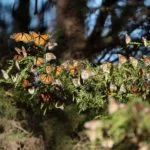
(WASHINGTON) — Monarch butterfly sightings may be sparser than usual in the U.S. and Canada following a drastic drop in populations wintering in Mexico, researchers told ABC News.
The annual census of the number of monarchs that winter in Central Mexico showed that the population decreased “precipitously,” the Xerces Society for Invertebrate Conservation, which conducts the research alongside the World Wildlife Fund-Mexico, announced on Wednesday.
The number of monarchs dropped from 2.2 hectares in the 2022-2023 season to 0.9 hectares in the 2023-2024 season — making this past winter the second-worst year ever recorded, according to the environmental nonprofit.
Each hectare is measured to contain about 21 million butterflies, Chip Taylor who is an emeritus professor of ecology and evolutionary biology at the University of Kansas and the founder and former director of conservation nonprofit Monarch Watch, told ABC News.
Monarch populations have declined drastically over the past 40 years, Anurag Agrawal, an evolutionary ecologist and professor of environmental studies at Cornell University, told ABC News.
In 1996, there were about 18 hectares — or about a billion — butterflies, Taylor said. The lowest year was during the 2013-2014 season when only 0.67 hectares were occupied, the researchers said.
Monarch butterflies typically spend the winter in a 50-mile stretch in Mexico at mid-elevations, from about November to February and early March, Taylor said. They feed on nectar, which converts into the fat the butterflies rely on to get through the season.
Once they make their way back north, it takes them 10 to 15 days to get to Texas and Oklahoma and other southern states and spend about six weeks laying their eggs, Taylor said. As the offspring are born in April and May, they migrate north and colonize the rest of the U.S. and southern Canada before the migration south begins during the first week of April.
During the most recent migration, as the monarchs moved south into Oklahoma and Texas, they faced drought, Taylor said. Once they got to Mexico, the drought that struck the region was so bad there was little nectar for the butterflies to feed on, Taylor said.
Insects all over the planet are facing a massive decline, Taylor said, adding that researchers are trying to figure out why.
Monarchs are especially an indicator species that could highlight overall environmental issues, Agrawal said.
“What makes monarchs so special is that they traverse Canada to Mexico, as, I like to say, tasting their way as they move,” he said. “And so, when their numbers are low, it suggests potentially that there are some threats.”
The biggest threats monarchs face are habitat loss and changes in weather patterns, Taylor said.
Warmer temperatures are having a negative effect on how monarch populations develop, Taylor said. In recent years, temperatures that remained “far too high” in September led to fewer monarchs being able to reach overwintering sites because it took too long for them to get there, Taylor said.
“There’s a lot of mortality during the winter, and then they have got an 800-mile trip to get back to the United States,” he said. “And that 800-mile trip, right now looks like it’s gonna be tough, because there’s a lot of drought.”
The warmer temperatures are also pushing monarchs further north, which could have implications on their current overwintering sites in Mexico in the future as well as the timing of the migration pattern, Agrawal said.
Despite the challenges, monarchs have historically displayed the capacity to deal with catastrophic mortality, the experts said. Monarchs have a good reproductive rate, presenting the possibility for them to bounce back, given the right conditions.
“Several bad years in a row means the demise of a species,” Agrawal said.
Monarchs are one of the more “charismatic” butterfly species because their abundance allows them to exist in playgrounds and backyards — places where people recreate, Agrawal said.
“It’s one of the reasons they’re so charismatic and have captured our imaginations as an icon of nature and of conservation,” he said.
Creating more habitat is the biggest priority in monarch conservation, the experts said. Individuals who want to help can plant a pollinator garden with milkweed and nectar plants native to the region to encourage the monarchs to feed along their annual migration route.
“Fewer monarchs hibernating in their traditional forest habitat in Mexico greatly concerns all of us,” said Jorge Rickards, general director of WWF Mexico, in a statement. “It’s critical that all communities, governments, non-governmental organizations, scientists, and others continue to strengthen our conservation and protection efforts to support the monarch’s unique migration.”
While monarch butterflies are listed as endangered on the International Union for Conservation of Nature’s Red List of Threatened Species, its eligibility to be added as a protected species under the U.S. Endangered Species Act hangs in the balance.
In December 2020, the U.S. Fish and Wildlife Service declared the species as “warranted but precluded.” This decision made monarch butterflies a candidate for protection, but its listing will be delayed as the agency prioritizes other candidates.
Moving forward on the listing is necessary to maximize protection and restoration of habitat across the monarch’s range and to protect them from toxic pesticides, said Scott Black, the executive director of the Xerces Society for Invertebrate Conservation, in a statement.
Copyright © 2024, ABC Audio. All rights reserved.
